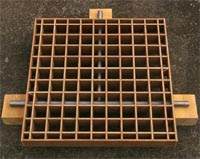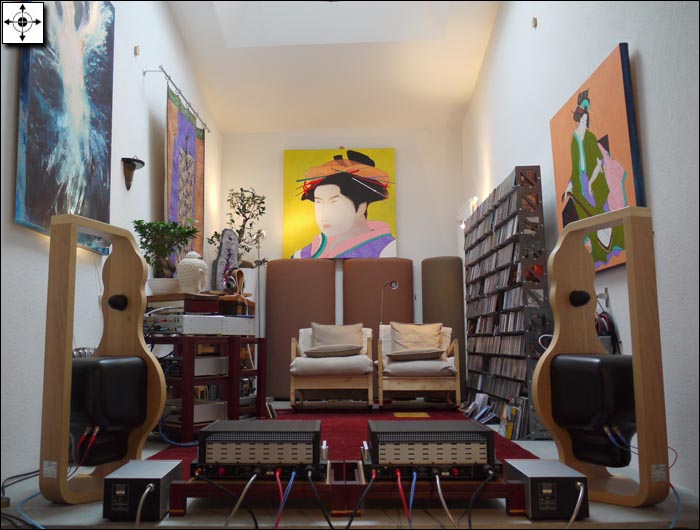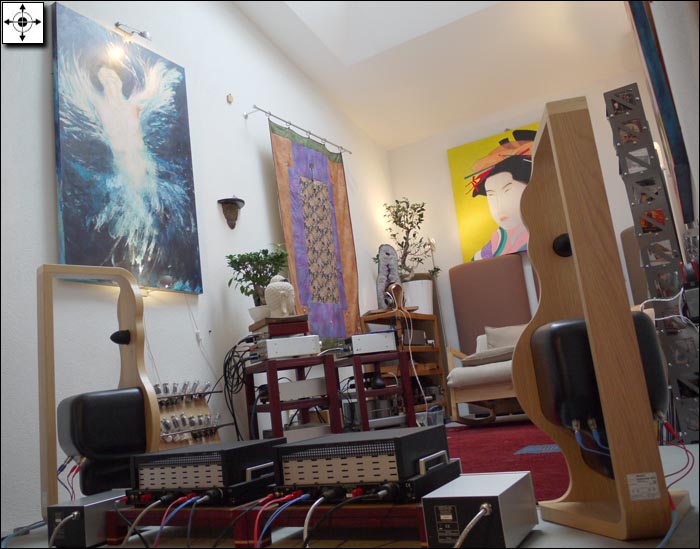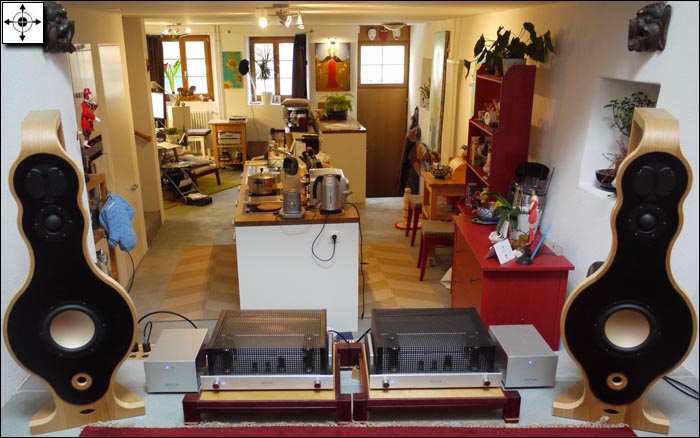This review page is supported in part by the sponsors whose ad banners are displayed below |
 |
 |
Concepts: On the website of the US Feastrex importer, this rationale appears for his new open-baffle Granada: "We have chosen an open baffle design. Why? Simply, with no box to contend with, there are no box colorations. The speaker drivers breathe naturally and present their pristine innate qualities. No box means bass that is clear and powerful and much less susceptible to room excitations."
|
 |
Describing meanwhile their new cross-brace shelves of a revised rack system, Rethm's designer Jacob George explained that "...essentially I believe in lighter is better to minimize energy
storage. It was a challenge designing a shelf that was light and strong and made of wood..."
|
|
These two quotes together counter Magico's new Q Series speaker proposition where heroic metal braces of already massive aluminum cabinets pursue the dead enclosure. For far lower prices, the box colorations which either speaker approach criticizes are far more effectively banished by the open baffles regardless of propaganda. It's easier, cheaper and a lot more efficient not having to battle a box in the first place.
|
|
|
|
 |
Against this obvious statement, it nearly seems lazy to compliment the Ballerina on its overtly unencumbered big sound and gargantuan staging. After all, we not only know about its construction, we're familiar also with speakers which despite their enclosures don't sound stuffy or any more encumbered than this sculpted baffle with its lossy bass bin. To be fair then, good results are possible either way. And OBs are no walk in the park. They're naturally challenged by the cancellation of frequencies where dipolar dispersion turns omnidirectional and counter-phase front and rear waves begin to interact and partially subtract. Hence Emerald Physic for example applies massive electronic equalization to linearize their open baffles.

PearlEvo's plastic canister—cosmetically the least attractive bit when viewed from the rear which most setups arguably wouldn't—is a both clever and effective antidote to the same problem. It lets their engineer have his open-baffle cake on sonic openness whilst enjoying unconventionally linear bass with good extension from a single smaller woofer. Where competing open baffles run dual 15s, PearlEvo keeps their speaker's profile friendly and compact (even the top model in this line runs the same frame).
To complete the pro/con itinerary, it must be said again that PearlEvo's bent-wood solution for their framed baffle is a lot costlier and more laborious than the ubiquitous but effective V-grooved MDF box construction. At their level of implementation, the ultra-cheap sheet o' plywood advantages of simple open baffles such as DIYers experiment with have been sacrificed. Yet it remains quite factual to say—because I own a pair, Zu Audio's Essence will stand in—that a competing €3,500 box speaker with an expensive stylish finish will not sound as box-less. To truly eliminate boxes as audible sound contributors takes more money than a Ballerina shopper has. For those keen on maximizing their limited funds then, the PearlEvo solution is particularly attractive and successfully addresses a number of common challenges.
|
|
|
The Ballerina is not ideal however for listeners whose circumstances enforce mostly low playback volumes. This speaker wants to be goosed a fair bit before it fully unfurls. While it doesn't need power to play—my 25-watt FirstWatt transistor amps worked very well to generate all required and desired SPLs—it sounded better and rather more dynamic and gutsy with real muscle behind it. A reasonable boiler plate figure would be 100wpc.
|
 |
There remains another concept to deal with. Just as the open construction supported intuitive predictions—about grand precise imaging without hollowness or blurring from box talk—so does the mixed batch of drivers (ribbon tweeter, soft-dome midrange, metal-alloy woofer) suggest its own consequences, albeit negatively. What must be texturally seamless transitions could be dominated by different driver signatures. Such a prediction hinges on a conceptual purity that's similar to zero negative feedback. Both are compelling arguments on paper. But any number of very good amplifiers do apply feedback though usually not in heaps and pounds. Likewise more than one speaker has managed to speak with a single voice despite employing drivers which are made from quite different materials.
|

|
Here the Ballerina does very well particularly in regard to mating the ribbon tweeter to the dome. Ribbons can sound texturally lean, unduly zippy and impose a cold metallic transient sharpness that lacks harmonic bloom. I was pleasantly surprised by how the Swans ribbon's steep 4th-order high-pass at 6,000Hz created an overall tonal balance that was far from dominated by any fluffy airiness or energized brilliance. Instead, the speaker sounded particularly meaty and peppy, likely because the presence region was handled by the small textile dome and all the upper-bass/lower-mid punch and impact by the well-damped stiff woofer.
Ribbon traits here very much reminded me of how Zu Audio harvested their TangBand version in the Essence model - for extension and mild sparkle fully integral to the vocal band rather than any lead role. The Ballerina in essence behaves like an unusually dynamic two-way monitor with super tweeter. Compared to the actual Essence, the Italian's resolution in the critical presence region is superior, meaning vocal enunciation is more articulate, string attacks are snappier and tone modulations more sophisticated. In overall image density, the Ballerina is second but she retaliates with bass that is subjectively faster and tauter but not as feisty. The biggest functional difference between these speakers is that the Zu will sound dynamic and plucky with modestly powered amplifiers while the PearlEvo really craves the higher octane juice. For textural warmth, the Zu includes higher cabinet contributions which the open Ballerina structure strips away. Vital in this context is that the quality of these Chinese drivers is such as to not rely on small box talk for full tone. Unless your amplifier is intrinsically lean, this speaker will not sound it. |
|
|
Much has been said here and elsewhere about Zu's sonic vintage focus; and how despite their recent embrace of a ribbon tweeter, the signature 10-inch modified Eminence widebander asked to stretch to 10,000Hz with its whizzer cone remains ultimately limited in very fine resolving power in the critical presence region. Those listeners attracted to the Zu concept and general sonics but hung up on this one specific item will be pleased to know that this 8-inch 3-driver Ballerina model offers a quite similar sonic take but eliminates Zu's minor opacity in that band. Conversely, the Zu comes alive faster at low levels. Compared to my Lowther-driven Rethm Saadhana however, neither remotely competes in the absolute whisper stakes nor is as astute in the finesse of tone modulations or microdynamic flutters. But the Americans and Italians both beat out the Indians when it comes time to rock out and crack hard in the bass on popular music. In short, in these realms one remains with given sets of compromises.
|
 |
How much bass can a quality 8-inch woofer produce? A lot more than the twin 18-inch brigade would ever admit. Naturally, the dividing line is drawn sharply with demanding SPLs. If you want Taiko drum thunder at lease-breaking levels, you need bad-ass artillery. That said, for levels I already consider beyond purely civilized and nicely into happy hour, the PearlEvo had more sock-'em power than expected to be as persuasive and sufficient as the Zu Essence.
|
 |
Bass integration with my unusually deep room setup was fabulous. I had enough oomph to load the space—admittedly requiring higher levels than over my usual triple-eight Tango R—without the latter's propensity to occasionally approach overload in the 60 - 100Hz band where my room geometry becomes reactive. An important moral of this aspect is, don't buy more bass than your room can integrate. Manly fascination with horsepower often applies the same more-is-better thinking but nothing interferes with the high in fidelity like dominant ringy bass. Here PearlEvo's chosen driver and bass loading are very correct on high-performance reality over wishful thinking.
|
|
|
While neither woofer diameter nor cubic volume of the bass bin telegraph high ambitions, this smallest of the Ballerina models really was all I'd ever want in my space from a bass power perspective. One clearly can go after more extension to really hit 20Hz with considerable force but that'll not only cost you dearly in the wallet, it just as likely will cause more problems than it solves for that rare occasional album.
|
The wrap: Scaled-up soundstaging which approached holographic intensity on certain recordings was one of the strongest suits of this unconventional speaker design. Following a close second was dynamic trigger happiness that quite had me at hello from an affordable speaker with conventional voltage sensitivity (this admittedly did require potent amplification). The next noteworthy aspect was tonal fullness even from leaner amplifiers like my FirstWatt samples. This should run counter to ribbon-based expectations but in truth, the ribbon here is nothing more than a craftily patched-in filler. The Ballerina is not a ribbon or 'electrostatic' speaker in the conventional sense. The key driver here is the ATC-reminiscent quality midrange dome.
This speaker also lets go of the notes quickly to suffer very little by way of blurring, fuzziness, overhang, hollowness or ringing. Holding on to the wooden top bridge during play demonstrates how actively the relatively lightweight frame dissipates fine vibrations, returning us to the earlier Rethm quote about 'lighter is better' in matters of energy storage. And
Signore Cremonesi's port clearly does not produce the common bloating effects to play its part in the general recipe of a quick, dynamic but not threadbare sound. While neither here nor there for prospective owners who install their speakers once, I personally was thrilled to be able to pick up the entire speaker at its rear brace with one hand and move it about like nothing. Death to the monkey coffins could be the bumper sticker most salient on a number of points.

In closing, I was just as impressed with this speaker in my own four walls as I had reason to believe I would be based on my first encounter at the Milan show.
A lot of clever thinking has gone into the PearlEvo Ballerina 301-8" to present known advantages of open baffles without most their cosmetic challenges particularly when solid bass into the mid 30s is desired. This Italian company also steps outside the norm by going after exclusively Chinese transducers and rethinking where to best locate their crossover transitions (900 and 6000Hz).
For most practical intents and purposes, the Ballerina is a two-way speaker with a very low transition frequency. The ribbon simply sneaks in for upper harmonic assistance only. Being cosmetically utterly unconventional will likely prove to be the most decisive variable. Asking my wife's opinion who like most women cares little for technical justifications about odd design choices, I was surprised to hear her compliment the Ballerina for its attractiveness and how well it integrated into our decor. While tastes remain personal and beauty in the eye of the beholder, I predict that PearlEvo has played their cards well also on this matter. In short, while clearly being different, the Ballerina has solid and demonstrable reasons for it which are very convincing where it matters - once set up and asked to play the music. Very well done!
|
|
 |
Quality of packing: Cardboard with inserts and plastic pouch.
Reusability of packing: Yes.
Condition of components received: Perfect.
Website comments: Requires more hard data on each speaker model.
Human interactions: Friendly and professional.
Final comments & suggestions: Intelligent solutions for common speaker problems combine with a distinctive cosmetic flair in a speaker that's different not for its own sake but for excellent reasons that are well argued indeed by the resultant performance. Grills aren't provided and the aesthetics support that decision. Particularly the fully exposed soft dome will run afoul of poking fingers and related carelessness however. This also applies to unpacking and setup so be mindful.
|
|
|
 |
|